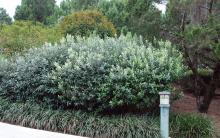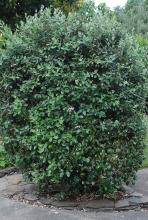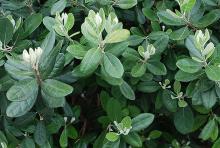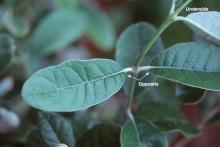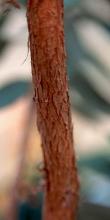Feijoa sellowiana
Common name:
Pineapple Guava
Feijoa
Pronunciation:
fa ho AH sel-low-i-A-na
Family:
Myrtaceae
Genus:
Synonyms:
Acca sellowiana
Type:
Broadleaf
Native to (or naturalized in) Oregon:
No
- Evergreen shrub or small tree, to about 20 ft (6 m) high and somewhat less in width, branches tomentose (dense matted hairs). Leaves simple, opposite, elliptical to ovate, 3-8 cm long and 2-4 cm wide, margin entire (smooth), apex obtuse, base rounded, glossy dark green above, silvery-white tomentose below. Flowers single, in lowest 2-4 leaf axils of current season's growth, 3-4 cm wide, 4 whitish petals with red centers, 4 sepals and numerous carmine colored stamens, yellow anthers, edible. Fruit ovate, 5 cm long, yellow-green to blue-gray, edible, pulp juicy, greenish white, tastes likened to pineapple with spearmint overtones or somewhat pear-like; may take 4-7 months to ripen, depending upon climate.
- Sun to light shade, well drained, loamy soil. Tolerant of drought and salt winds, used as a hedge in coastal garden in mild climates. Habit is loose and open, rather dense if pruned. Can withstand much pruning and training (espalier, screen, hedge, or small tree).
- Hardy to USDA Zone 8 Native to southern Brazil, Uruguay, Paraguay, and northern Argentina. Several cultivars available.
- Cultivars such as 'Beechwood', 'Coolidge', 'Mammoth', 'Nazemetz' and 'Trask' are self-fruitful, but reportedly cross-pollination will result in more fruit. Single plants derived from seedlings or other cultivars may need cross-pollination (Sunset Western Garden Book, 2001).
-
Naming this plant: Feijoa sellowiana ------> Acca sellowiana ------> Feijoa sellowiana
- This plant has long been called Feijoa sellowiana but in 1941 it was thought this name had been incorrectly applied. The German botanist Otto Karl Berg (1816-1866) first described this plant as Feijoa sellowiana in 1859. In 1856, three years prior, Berg had given the name Acca domingensis to another South American plant in the Myrtaceae. In 1941 Karl Ewald Maximilian Burret (1883-1964), a German research botanist combined these two genera, so the valid name of this plant became Acca sellowiana. Then 78 years later, a 2019 paper in Systematic Botany titled 'A New Subtribal Classification of Tribe Myrteae (Myrtaceae)" (Vol. 44, N. 3 pp 560-569) made the case that Acca sellowiana was not closely related to Acca lanuginosa, the type species of the genus, and hence the name Feijoa sellowiana was reinstated. . The name for the genus honors João da Silva Feijó (1760-1824), a Portuguese naturalist born in Brazil. The specific epithet "sellowiana" honors Friedrich Sello (Sellow) (1789-1831) a German botanist who collected in South America. (from San Marcos Growers, https://www.smgrowers.com/)
- Oregon State Univ. campus: northeast corner of Finely Hall (dorm) (Washington Way).


